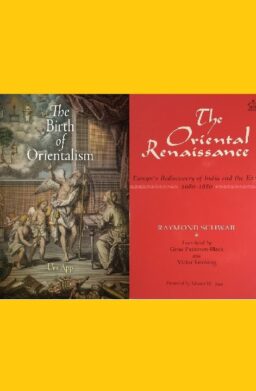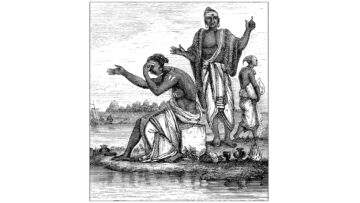…Continued from Part I
Comparison and Review of the Content: What are the main ideas and themes presented? What do we learn from these books?
Towards the end of the nineteenth century, the Oriental renaissance and ‘Indomania’ fizzled out. There are many reasons as to why, but I would say the primary reason is because the Orientalists did not produce knowledge about India. This is because, contrary to what they were saying, they were not doing science, they were doing theology. The Orientalists were looking for answers to theological questions within Sanskrit texts, which they assumed were religious scriptures. This presupposition itself comes from a Biblical view of human history, and assumptions about human nature that were shared in common between different Christian theologies, and had become widely accepted by Europeans of that time period. For example, Schwab mentions in the beginning of his book that many of the nineteenth century European thinkers thought that ‘’Sanskrit was the providential answer…Through Sanskrit came the material destined to fill in the preliminary outlines of the philosophy of history.’’ (Schwab et al., 1987, p. 13).
German philosopher and theologian Johann Herder is considered by many to be one of the progenitors of European nationalism, romanticism as well as philosophy of history. In his manuscript Ideas on the Philosophy of the History of Mankind (1784-91), Herder refers to the Orient as the soil of God, elected for the purpose of realizing the philosophy of history. But what does it mean to say that a group of people or a nation has been elected? What is this philosophy of history that Herder is talking about?
This philosophy of history envisioned a universal human history governed by the will of God, that has a telos or purpose. According to this view of human history, God revealed his will in the form of doctrines and laws to humanity in its original pristine condition. However, this revelation became corrupted over time, and the pure monotheism became many forms of idolatrous religions. The corruption of God’s revelation corresponds to the fracturing of the original language of humankind into many tongues, and the fracturing of the human race into many nations. It was thought that in the beginning of human history, there was a perfect communion between man and God. This communion later became broken and the end of human history is supposed to be the reestablishment of this divine communion between man and God. This in a nutshell is the view of human history and religion shared by the nineteenth century Orientalists who studied India. Within this philosophy of history, each nation is elected to play a specific role in God’s plan. Many of the Orientalists thought that in India, they had found the nation which would play an instrumental role in reestablishing the communion between man and God, and make humanity whole again. They thought that Sanskrit was the original (or at least the closest living ancestor to the original) language, and that the Vedas were the sacred scriptures that were supposed to contain at the very least, fragments of God’s primordial revelation to humanity, that later became lost or corrupted. Even thinkers, who explicitly rejected Christianity such as Voltaire, approached India and Indian texts through these above set of assumptions.
The end result of Orientalist/Indologist writings is not a description of India, but the description of the European experience of India. It is worth mentioning that the Orientalists hardly came into contact with real flesh and blood Indians. Their India was the India of the so called Sanskrit scriptures and philosophies interpreted within the framework of Christian theology and Biblical history. Theirs was an India formed in the libraries, universities and salons of Europe.
However, while the writings of the Orientalists may be worthless for one trying to learn about India, it is a useful tool for understanding European culture, through studying how the Europeans experienced Indian culture. It is this observation more than any that I wish for Indic readers to take from this book review.
Out of the two books, The Birth of Orientalism does a much better job of clearly pointing out and explaining the Christian framework which guided the Europeans’ study of India. Although one can parse out this theological framework from Schwab’s The Oriental Renaissance, it requires the discerning eye of someone already familiar with research on Oriental Studies. By contrast, The Birth of Orientalism uses various case studies to systematically outline and analyze how the search for the Ur-religion drove the European study of India during the enlightenment period and beyond.
For Indic readers, I would say only the first two hundred pages of The Oriental Renaissance are worth reading. The bulk of the rest of the book is about French literary writers and how their writings were influenced by Indological Orientalism, and is not very interesting.
Comparison and Review of the Writing Style
When comparing the writing style of both books, the clear winner is The Birth of Orientalism. The author of The Oriental Renaissance uses an extremely verbose and obfuscating writing style, which made it very difficult for me as a reader to follow a train of thought. Although the events and ideas narrated in The Oriental Renaissance follow a certain chronology given that it is a historiographical work, I found its paragraphs to be extremely unstructured and lacking in flow. Perhaps these problems are explained by the fact that this book is an English translation of a work that was originally in French. Another problem with this book is that the author makes passing references to the names of European thinkers, their writings, and also movements in European history (e.g. Romanticism), which he assumes the readers are familiar with.
By contrast, The Birth of Orientalism is written in a much more lucid style. It is a tight, well structured work that flows well paragraph to paragraph, chapter to chapter. I think this is because it is not a historiography and instead focuses on tracing common themes and ideas in pre nineteenth century European encounters with and writings about India.
Overall Evaluation and Comparison
Both books make for an interesting read for readers interested in learning about the birth and development of Orientalism and Indology. Schwab has given a very thorough and detailed historiography of the Oriental renaissance, and does a good job of capturing the mood, atmosphere and energy of that period. The major downside of The Oriental Renaissance however, is that is an extremely verbose book that uses obfuscating language, and assumes that the reader is already familiar with Orientalist writings and European history. In contrast, The Birth of Orientalism is much more accessible.
For the lay Indic reader who wants to read a focused study written in a lucid style about why Europeans described India in a certain way, and what is it about their culture that causes them to experience Indian culture and interpret Indian texts in a particular way, The Birth of Orientalism is a must read. Unlike Schwaab’s The Oriental renaissance, which is simply a historiography with some interesting ideas and information, this is a clear, focused and systematic study of how certain ideas and questions that emerged from different Christian theologies became the foundation for how Europeans during the early modern period studied and described India. These descriptions gave rise to the commonplace attitudes and descriptions about Hinduism that we see in various media today. Given these considerations, I would highly recommend Urs App’s The Birth of Orientalism over Raymond Schwab’s The Oriental Renaissance.
Conclusion: How is nineteenth century Orientalism relevant to Indians of today?
I will begin this conclusion with a beautiful quote from a French Indologist named Anquetil-Duperon which expresses a dream: ‘’Soon the chill of age will ice the blood in my veins. I will have, at least, the satisfaction of car-rying to my grave the hope of seeing India linked to Europe through the rapport, the communication of minds and ideas, more worthy of man than the vile objects of commerce—gold, silver, gems, fabrics, spices—which have until now united the two continents. I will die happy in saying: the Indians may love us.” (Schwab et al., 1987, p. 163)
Even though the Orientalists didn’t produce knowledge about India, one must at least respect the love for knowledge with which they approached the subject matter. Many of them wanted to develop a genuine understanding and relationship between the two cultures. This is in stark contrast to most of the academics and scholars of today who work in the fields of Indic studies and social sciences, who are driven by ideology rather than the love of knowledge, whether it be from the left or right. Furthermore, the Orientalists of yore were free to pursue knowledge without being hampered by the requirements, standards and bureaucracy of academia.
Now we come to the million dollar question: Why should the Indians of today care about what a bunch of nineteenth century Europeans wrote about us? While the men who wrote them are long gone, their descriptions of India still live on today. During colonialism, the British rulers presented these Orientalist descriptions as facts and truths about India, instead of the experience of one culture. These descriptions were foisted upon Indians through the colonial education system and were accepted as facts by Indians themselves. Professor Balagangadhara calls this phenomenon colonial consciousness (Balagangadhara, 2012, pp. 64-81). The fact that we still talk about the Hindu religion, Vedas as sacred scriptures, and Brahmins as priests, shows that Orientalism is alive and well. Not only is it alive and well, it has a pernicious effect on how we understand and relate to our culture. The Orientalist descriptions act like a film of dirt that clouds our vision and prevents us from accessing our own cultural experience.
Studying the Orientalist descriptions as the experience of Western culture rather than knowledge about Indian culture, will simultaneously help us understand Western culture, and at the same time help us access Indian culture and traditions without these descriptive occlusions. When that happens, we will have taken a major step closer to realizing Duperron’s noble dream.
Bibliography
App, U. (2010). The birth of Orientalism. In University of Pennsylvania Press eBooks.
Balagangadhara, S. (2012). Reconceptualizing India Studies.
Guruswamy, M. (2022, August 19). Mohan Guruswamy | How did we do in 75 years? Clearly, better than most. Deccan Chronicle. https://www.deccanchronicle.com/opinion/columnists/180822/how-did-we-do-in-75-years-clearly-better-than-most.html#:~:text=At%20the%20time%20when%20India,215%20million%20Indians%2C%20were%20poor.
Livemint. (2023, October 11). India to be $30 trillion economy by 2050 with per capita income of $21,000: HDFC Bank chief Atanu Chakraborty | Mint. Mint. https://www.livemint.com/economy/india-to-be-30-trillion-economy-by-2050-with-per-capita-income-of-21-000-hdfc-bank-chief-atanu-chakraborty-11697031442896.html
Schwab, R., Patterson-Black, G., Reinking, V., & Said, E. W. (1987). The Oriental Renaissance: Europe’s Rediscovery of India and the East, 1680 to 1880.
World Bank Group. (2023, October 3). India’s Growth to Remain Resilient Despite Global Challenges. World Bank. https://www.worldbank.org/en/news/press-release/2023/10/03/india-s-growth-to-remain-resilient-despite-global-challenges#:~:text=The%20IDU%2C%20the%20Bank’s%20flagship,average%20for%20emerging%20market%20economies.
Disclaimer: The opinions expressed in this article belong to the author. Indic Today is neither responsible nor liable for the accuracy, completeness, suitability, or validity of any information in the article.










